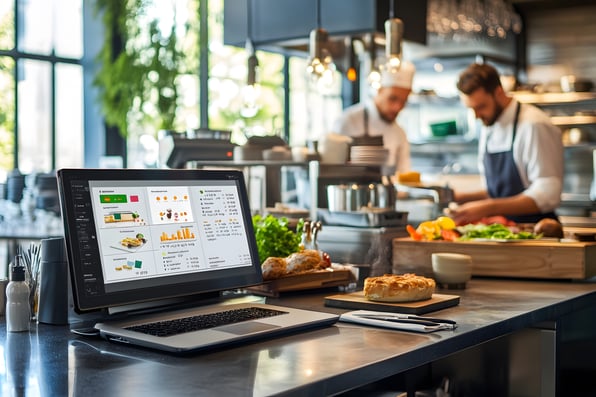Understanding How Menu Personalization Improves Resident Satisfaction

Mealtime is one of the most anticipated parts of the day in senior living communities, and for good reason! Beyond providing nutrition, a thoughtfully prepared meal brings comfort, enjoyment, and a sense of normalcy. It’s also a time for social opportunities — building connections and having conversations with others in a place that can oftentimes feel isolating.
Food quality and choice have a major impact on resident satisfaction and retention. Families are paying closer attention to what’s on the menu and how it reflects their loved one’s needs, values, and preferences.
That’s where menu personalization makes a difference. Personalized dining shows residents they’re seen and valued, and turns everyday meals into meaningful experiences.
What Menu Personalization Means in Senior Living
Personalizing senior living community menus helps the dining experience meet the individual needs, tastes, and routines of each resident. This way, meals feel less like a service and more like a personal choice. Menu personalization can include:
- Flavor and food preferences based on lifelong favorites, cultural dishes, or even sensitivities to textures and spices.
- Medical or dietary needs, such as low-sodium, diabetic-friendly, or texture-modified options.
- Religious and cultural dietary traditions, including vegetarian, kosher, halal, or fasting accommodations.
- Flexible schedules that allow residents to eat when it suits them, not just during fixed service times.
- Visual and accessible menus that support memory care, language preferences, or low vision.
- Portion control options, recognizing that not all appetites are the same.
- Ordering flexibility, whether through touchscreens, in-room ordering, caregiver input, or family members assisting from afar.
Key Factors That Influence Resident Dining Satisfaction
Satisfaction with resident dining isn’t tied to just one trait. It’s the result of many small choices that shape each mealtime experience. Communities that understand what matters most can better meet expectations and build programs that truly resonate.
Here are some of the key factors that influence how satisfied your residents are with their dining experience:
- Individual Food Preferences and Meal Variety: Offering meals that reflect residents’ personal tastes, along with enough variety to keep things interesting, helps prevent menu fatigue and keeps mealtimes enjoyable.
- Choice in Mealtimes and Portion Sizes: Flexibility around when and how much residents eat to respect their routines and support a sense of independence.
- Accommodation of Dietary Needs: Meeting medical or health-related dietary requirements reliably and with appealing options builds trust and improves overall well-being.
- Cultural and Religious Dietary Traditions: Honoring dietary traditions is a matter of identity and inclusion for many residents.
- Level of Control and Autonomy: The more residents have a say in their meals, the more empowered and satisfied they tend to feel. Personal choice supports dignity and self-expression.
- Engagement and Interaction Around Food: Whether they’re chatting with staff about the menu, taking part in tasting events, or offering feedback, meaningful engagement around food adds to the enjoyment and creates a more personalized experience.
How Menu Personalization Leads to Happier, Healthier Residents
Personalizing your residents’ dining experience has a direct impact on their physical health, wellness, and overall satisfaction. When meals are made to meet their nutritional needs and preferences, residents are more likely to eat well, feel heard, and engage in community social activities.
Increased Food Intake and Appetite
When residents are served meals they genuinely enjoy, ones that have the flavors, textures, and portion sizes that suit their unique needs, they’re more likely to willingly eat. Personalized menus help encourage eating by making meals more appealing, especially for older adults dealing with health conditions that impact taste or appetite.
Improved Nutrition
When dining options are tailored to what each resident likes and needs, it’s a lot easier to hit nutritional goals without making food feel like a chore. Whether someone’s watching their sodium intake, looking for gluten-free options, managing diabetes, or trying to build strength with more protein, these personalized menus help deliver the right nutrients in meals they actually enjoy eating.
Reduced Mealtime Stress and Confusion
Too many choices or unfamiliar dishes can make mealtimes feel overwhelming, especially for residents with memory loss or sensory sensitivities. Personalized menus simplify the experience. But when food is familiar, visually presented, or chosen with a caregiver’s help, it helps residents feel a bit more at ease and comfortable about what’s being served.
Promotes Autonomy, Dignity, and a Sense of Control
Even small choices can make a big difference. Letting residents decide what they want to eat, how much, and when gives them more control in their day. That sense of autonomy, especially when living in a senior living community where life is a bit more structured, helps them feel like their preferences and routines still matter — because they do.
Strengthens Emotional Connections to Meals and Community Life
A favorite dish can spark memories or help someone feel more at home. Personalized dining services open the door to more meaningful meals, where residents see a reflection of their culture, history, and personal tastes. That emotional connection helps build a stronger sense of community, too.
Fewer Complaints and Increased Satisfaction Scores
When residents get meals they like and feel heard in the process, they’re naturally more satisfied. Personalized meal plans lead to fewer complaints, more compliments, and better dining feedback overall. That kind of response doesn’t just boost kitchen staff morale; it shows up in satisfaction scores and helps set your community apart for potential residents.
Operational Challenges of Menu Personalization
Offering personalized menus can do wonders for resident satisfaction, but it also adds layers of complexity behind the scenes. Whether you’re trying to keep up with evolving dietary needs or making sure service is consistent across teams, there are some big challenges senior living dining teams face when bringing personalization to life.
Managing a Wide Range of Food Options
Giving residents the ability to pick their meal choices means communities need a variety of meals that cater to different tastes, textures, portion sizes, and dietary needs. That means planning and prepping more fresh ingredients, rotating menus more often, and training staff on a wider range of recipes. But, without the right tools or workflows, this level of variety can quickly become overwhelming.
Tracking Changing Dietary Restrictions, Allergies, and Resident Preferences
Residents’ needs can change over time, especially as they get older. Allergies can develop, new medications can impact diets, and personal tastes can simply shift. Manually tracking all of that, and making sure it reaches the right people in the kitchen, can be a major challenge. Without a centralized system, there’s more room for error and more time spent on updates.
Maintaining Consistency Across Shifts, Staff, and Locations
When personalized dining programs depend heavily on staff memory or handwritten notes, consistent culinary experiences suffer. One team member might know a resident loves extra gravy, while another doesn’t. Then, if your assisted living community has multiple locations, this inconsistency can be even more pronounced, resulting in uneven experiences and missed opportunities to deliver on high-quality personalization.
Balancing Customization with Kitchen Efficiency
Personalization should never come at the cost of timely and smooth kitchen operations. But that balance isn’t always easy. If teams are scrambling to make last-minute swaps or trying to accommodate unfamiliar requests on the fly, it can lead to delays, food waste, or team burnout. The key is finding systems that streamline customization without slowing things down.
How Dining Management Software Enables Personalization at Scale
Personalization can feel like a lofty goal, especially in communities serving dozens, or even hundreds, of residents each day. But with the right dining software, it’s possible to deliver first-class dining experiences to your residents without overwhelming staff or disrupting operational efficiency. Here’s how platforms like eMenuCHOICE help dining teams make it happen:
- Automatic Dietary Profiles and Preferences Tracking: No more flipping through binders or chasing down sticky notes. Dining software keeps up-to-date records of each resident’s dietary restrictions, allergies, portion preferences, texture modifications, and more, all in one place.
- Resident and Staff-Facing Ordering Platforms: Easy-to-use ordering tools (in-room, on touchscreen kiosks, or caregiver-assisted tablets) make it simple to select meals that match each resident’s needs and tastes without adding pressure to staff during service times.
- Real-Time Visibility for Kitchen Teams: Orders flow directly to the kitchen in real time, with all necessary details like modifications or allergen alerts all clearly flagged. This helps staff prep and plate confidently, accurately, and safely.
- Menu Cycle Management With Built-In Personalization Options: Instead of starting from scratch each time, communities can create flexible base menus with optional add-ons and substitutions. This helps standardize planning while still offering meaningful choice.
- Ordering Trend Analysis for Smarter Planning: Over time, software captures valuable data, letting your team know what residents are choosing (and what they’re skipping). This helps adjust your offerings to better match their actual preferences.
- Feedback-Driven Menu Updates: Integrating with satisfaction surveys or informal meal feedback means your menus evolve based on real input, not guesswork.
Real-World Results From Personalized Dining Programs
Don’t just take our word for it. Civitas Senior Living partnered with eMenuCHOICE and experienced firsthand how providing personalized dining experiences for their residents resulted in increased dining revenue plus much more.
After implementing eMenuCHOICE, Civitas saw:
- Increased Revenue: By offering up to 15 personalized entrée options per day, they captured more meal sales and reduced missed opportunities.
- Lower Costs, Less Waste: With tailored menus and data-driven production, kitchens avoided overbuying and were able to plan more efficiently, helping to reduce waste and boost margins.
- Better Resident & Staff Satisfaction: Staff appreciated clear data and tools; residents enjoyed meals aligned with their tastes. As Taylor Richey, VP of Food & Beverage, put it, seeing monthly revenue growth helped them invest in higher wages and better equipment for their teams.
- Stronger Vendor Partnership: Civitas praised EMenuCHOICE's responsiveness, including our monthly check-ins, prompt updates, and feature enhancements based on user feedback, helping to create a true partnership.
How to Get Started With eMenuCHOICE
Bringing menu personalization to life doesn’t have to be complicated. With eMenuCHOICE, your community can enjoy an intuitive and scalable platform that simplifies dining operations while delivering delicious meals that residents actually look forward to. Our platform helps your kitchen do more with less stress. It’s flexible enough to support multiple service styles and robust enough to deliver real-time insights that shape better experiences. If you're ready to transform the personalized dining experience in your senior care community, schedule a meeting to speak with one of our representatives.



